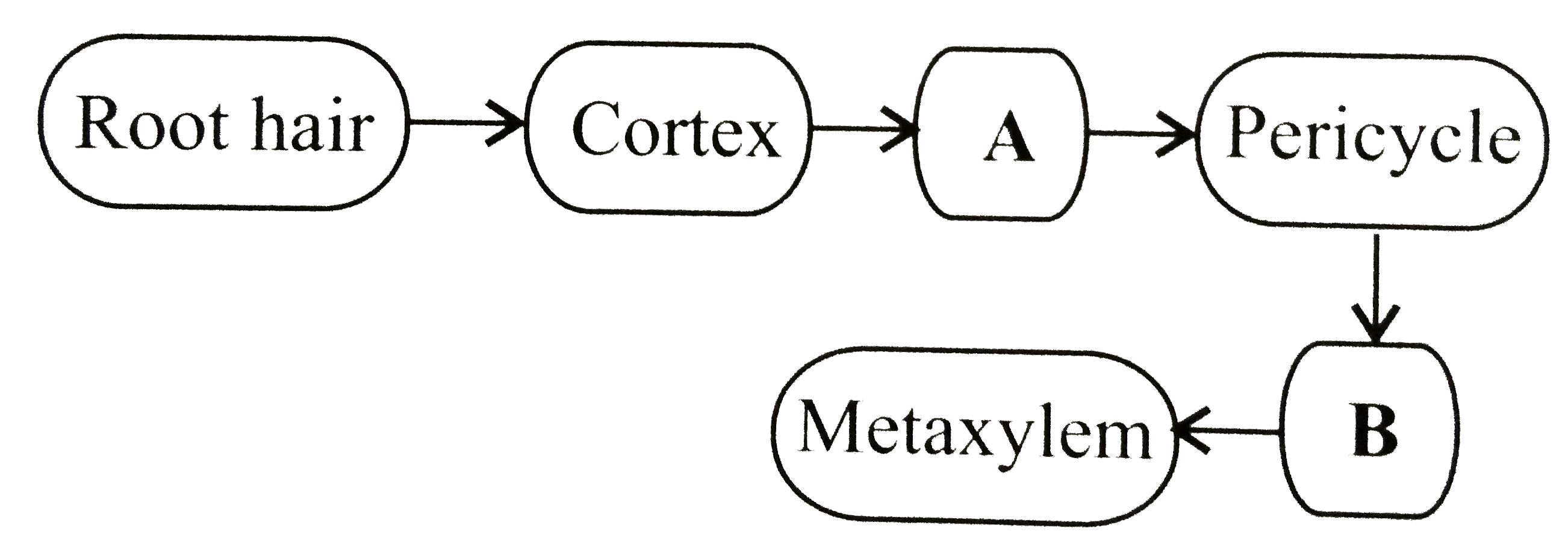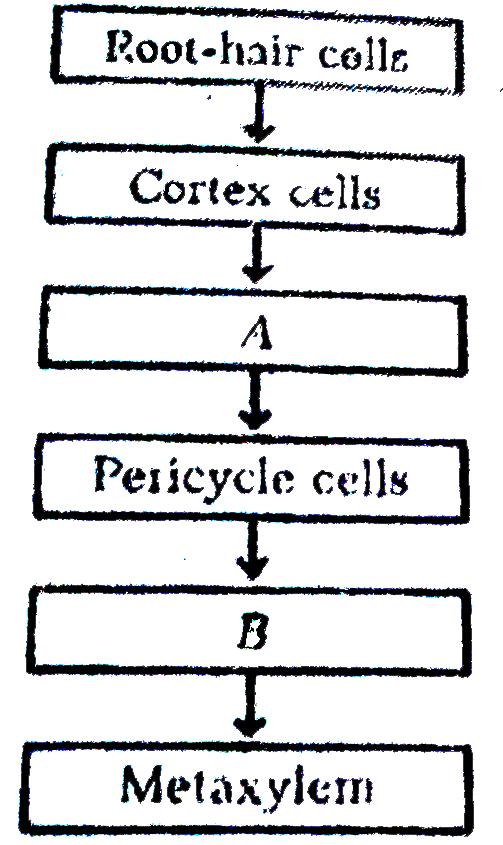Path of water movement from soil to xylem is
Metaxylem → Protoxylem → Cortex → Soil → Root hair
Cortex→ Root hair → Endodermis → Pericycle → Protoxylem → Metaxylem
Soil → Root hair → Cortex → Endodermis → Pericycle → Protoxylem → Metaxylem
Pericycle → Soil → Root hair → Cortex → Endodermis → Protoxylem to Metaxylem
The correct Answer is:C
To understand the path of water movement from soil to the xylem in plants, we can break it down into several steps:
1. Water Absorption from Soil:
- Water is absorbed by the roots from the soil. This process primarily occurs through root hairs, which increase the surface area for absorption.
2. Movement through the Epidermis:
- After absorption, water moves through the epidermis of the root. The epidermis can facilitate water movement through two pathways: the apoplast pathway and the symplast pathway.
- Apoplast Pathway: Water moves through the cell walls and intercellular spaces without crossing any cell membranes.
- Symplast Pathway: Water moves from cell to cell through the cytoplasm via plasmodesmata (small channels connecting plant cells).
3. Entering the Cortex:
- As water moves into the cortex (the layer of tissue beneath the epidermis), it can continue through both pathways (apoplast and symplast) until it reaches the endodermis.
4. Endodermis and Casparian Strip:
- The endodermis is the innermost layer of the cortex and contains a structure called the Casparian strip, which is a band of cell wall material that is impregnated with suberin (a waxy substance).
- The Casparian strip forces water to enter the symplast pathway, as it blocks the apoplast pathway. This ensures that water must pass through the cell membranes, allowing for selective absorption of minerals and nutrients.
5. Movement into the Xylem:
- After passing through the endodermis, water enters the xylem vessels. The xylem is responsible for transporting water and dissolved minerals from the roots to the rest of the plant.
Final Pathway Summary:
The path of water movement from soil to xylem can be summarized as:
Soil → Root Hairs → Epidermis (Apoplast/Symplast) → Cortex (Apoplast/Symplast) → Endodermis (Symplast due to Casparian strip) → Xylem.
---
- Water is absorbed by the roots from the soil. This process primarily occurs through root hairs, which increase the surface area for absorption.
- After absorption, water moves through the epidermis of the root. The epidermis can facilitate water movement through two pathways: the apoplast pathway and the symplast pathway.
- Apoplast Pathway: Water moves through the cell walls and intercellular spaces without crossing any cell membranes.
- Symplast Pathway: Water moves from cell to cell through the cytoplasm via plasmodesmata (small channels connecting plant cells).
- As water moves into the cortex (the layer of tissue beneath the epidermis), it can continue through both pathways (apoplast and symplast) until it reaches the endodermis.
- The endodermis is the innermost layer of the cortex and contains a structure called the Casparian strip, which is a band of cell wall material that is impregnated with suberin (a waxy substance).
- The Casparian strip forces water to enter the symplast pathway, as it blocks the apoplast pathway. This ensures that water must pass through the cell membranes, allowing for selective absorption of minerals and nutrients.
- After passing through the endodermis, water enters the xylem vessels. The xylem is responsible for transporting water and dissolved minerals from the roots to the rest of the plant.
The path of water movement from soil to xylem can be summarized as:
Soil → Root Hairs → Epidermis (Apoplast/Symplast) → Cortex (Apoplast/Symplast) → Endodermis (Symplast due to Casparian strip) → Xylem.
Topper's Solved these Questions
- TRANSPIRATION IN PLANTSBOOK - CENGAGE BIOLOGYCHAPTER - TRANSPIRATION IN PLANTSEXERCISE - CHALLENGING EXERCISE
2 Videos
- TRANSPIRATION IN PLANTSBOOK - CENGAGE BIOLOGYCHAPTER - TRANSPIRATION IN PLANTSEXERCISE - CONSOLIDATED EXERCISE (MCQ)
22 Videos
- RESPONSE AND CO-ORDINATION IN PLANTSBOOK - CENGAGE BIOLOGYCHAPTER - RESPONSE AND CO-ORDINATION IN PLANTSEXERCISE - CHALLENGING EXERCISE
3 Videos
Similar Questions
Knowledge Check
Path of water movement from soil to xylem is
Asolil→h√air→cortex→pericyc≤→endodermis→mηxylme→pro→xylmeBsoil→h√ari→cortex→endodermis→pericyc≤→pro→xy≤m→mηxylmeCsoil→h√ari→eπdermis→phloem→xylmeDsoil→h√air→eπdermis→cortex→pho≤m→rxy≤mThe pathway of water from soil upto the xylem :
ASoil → root hair → cortex → endodermis → pericycle → protoxylem Meta xylemBMetaxylem → protoxylem → pericycle → cortex → endodermis → soil → root hairCCortex → root hair → endodermis → pericycle → protoxylem → metaxylemDPericycle → soil → root hair →cortex → endodermis → protoxylem metaxylemThe path of water from soil upto secondary xylem is
ASoil → Root hair cell wall → Cortex Endodermis → Pericycle → Protoxylem → MetaxylemBMetaxylem → Protoxylem → Cortex → Soil → Root hairCCortex → Root hair → Endodermis → Pericycle → Protoxylem → MetaxylemDPericyle → Soil → Root hair → Cortex → Endodermis → Protoxylem → Metaxylem
In the given flow chart the flow of water is shown from soil to xylem of the root. Identify the tissues involved in steps A nad B

View SolutionAssertion : Entry of water from soil into xylem takes place through gradient of suction pressure.
Reason : Water moves from a place of higher suction pressure to a place of lower suction pressure.
View SolutionThe entry of water from the soil up to xylem elements of root is due to :
View SolutionThe path of water from soil upto secondary xylem is
View SolutionThe main driving force behind the upward movement of water through xylem is _____
View Solution

